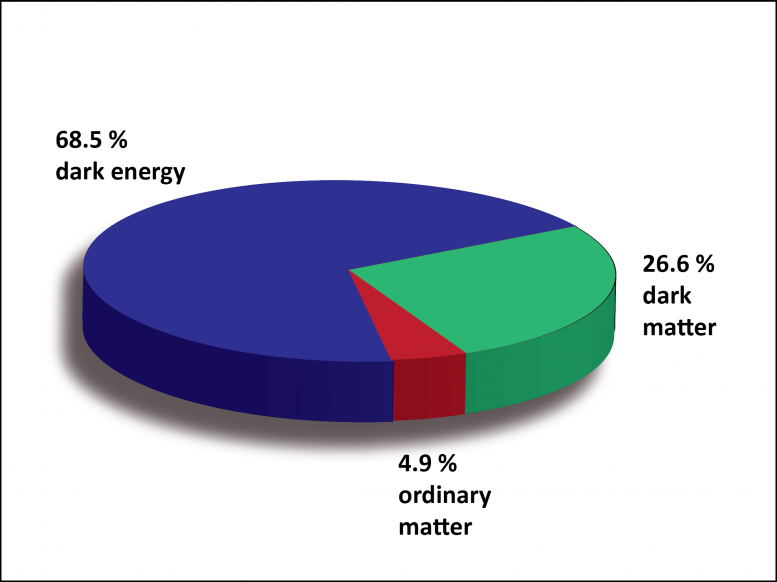
Researchers propose a pioneering method to detect dark matter. Using millimeter-sized pendulums as sensors, the experiment aims to uncover dark matter’s gravitational interactions with visible matter, even at the scale of a grain of salt. Credit: NIST
Researchers have proposed a novel method for finding dark matter.
Researchers at the National Institute of Standards and Technology (NIST) and their colleagues have proposed a novel method for finding dark matter, the cosmos’ mystery material that has eluded detection for decades. Dark matter makes up about 27% of the universe; ordinary matter, such as the stuff that builds stars and planets, accounts for just 5% of the cosmos. (A mysterious entity called dark energy, accounts for the other 68%.)
According to cosmologists, all the visible material in the universe is merely floating in a vast sea of dark matter — particles that are invisible but nonetheless have mass and exert a gravitational force. Dark matter’s gravity would provide the missing glue that keeps galaxies from falling apart and account for how matter clumped together to form the universe’s rich galactic tapestry.
The proposed experiment, in which a billion millimeter-sized pendulums would act as dark matter sensors, would be the first to hunt for dark matter solely through its gravitational interaction with visible matter. The experiment would be one of the few to search for dark matter particles with a mass as great as that of a grain of salt, a scale rarely explored and never studied by sensors capable of recording tiny gravitational forces.
Dark matter, the hidden stuff of our universe, is notoriously difficult to detect. In search of direct evidence, NIST researchers have proposed using a 3D array of pendulums as force detectors, which could detect the gravitational influence of passing dark matter particles. When a dark matter particle is near a suspended pendulum, the pendulum should deflect slightly due to the attraction of both masses. However, this force is very small, and difficult to isolate from environmental noise that causes the pendulum to move. To better isolate the deflections from passing particles, NIST researchers propose using a pendulum array. Environmental noise affects each pendulum individually, causing them to move independently. However, particles passing through the array will produce correlated deflections of the pendulums. Because these movements are correlated, they can be isolated from the background noise, revealing how much force a particle delivers to each pendulum and the particle’s speed and direction, or velocity. Credit: NIST
Previous experiments have sought dark matter by looking for nongravitational signs of interactions between the invisible particles and certain kinds of ordinary matter. That’s been the case for searches for a hypothetical type of dark matter called the WIMP (weakly interacting massive particles), which was a leading candidate for the unseen material for more than two decades. Physicists looked for evidence that when WIMPs occasionally collide with chemical substances in a detector, they emit light or kick out electric charge.
Researchers hunting for WIMPs in this way have either come up empty-handed or garnered inconclusive results; the particles are too light (theorized to range in mass between that of an electron and a proton) to detect through their gravitational tug.
With the search for WIMPs seemingly on its last legs, researchers at NIST and their colleagues are now considering a more direct method to look for dark matter particles that have a heftier mass and therefore wield a gravitational force large enough to be detected.
“Our proposal relies purely on the gravitational coupling, the only coupling we know for sure that exists between dark matter and ordinary luminous matter,” said study co-author Daniel Carney, a theoretical physicist jointly affiliated with NIST, the Joint Quantum Institute (JQI) and the Joint Center for Quantum Information and Computer Science (QuICS) at the University of Maryland in College Park, and the Fermi National Accelerator Laboratory.
The researchers, who also include Jacob Taylor of NIST, JQI, and QuICS; Sohitri Ghosh of JQI and QuICS; and Gordan Krnjaic of the Fermi National Accelerator Laboratory, calculate that their method can search for dark matter particles with a minimum mass about half that of a grain of salt, or about a billion billion times the mass of a proton. The scientists reported their findings on October 13, 2020, in Physical Review D.

Dark matter, the hidden stuff of our universe, is notoriously difficult to detect. In search of direct evidence, NIST researchers have proposed using a 3D array of pendulums as force detectors, which could detect the gravitational influence of passing dark matter particles. Credit: NIST
Because the only unknown in the experiment is the mass of the dark matter particle, not how it couples to ordinary matter, “if someone builds the experiment we suggest, they either find dark matter or rule out all dark matter candidates over a wide range of possible masses,” said Carney. The experiment would be sensitive to particles ranging from about 1/5,000 of a milligram to a few milligrams.
That mass scale is particularly interesting because it covers the so-called Planck mass, a quantity of mass determined solely by three fundamental constants of nature and equivalent to about 1/5,000 of a gram.
Carney, Taylor, and their colleagues propose two schemes for their gravitational dark matter experiment. Both involve tiny, millimeter-size mechanical devices acting as exquisitely sensitive gravitational detectors. The sensors would be cooled to temperatures just above absolute zero to minimize heat-related electrical noise and shielded from cosmic rays and other sources of radioactivity. In one scenario, a myriad of highly sensitive pendulums would each deflect slightly in response to the tug of a passing dark matter particle.
Similar devices (with much larger dimensions) have already been employed in the recent Nobel-prize-winning detection of gravitational waves, ripples in the fabric of space-time predicted by Einstein’s theory of gravity. Carefully suspended mirrors, which act like pendulums, move less than the length of an atom in response to a passing gravitational wave.
In another strategy, the researchers propose using spheres levitated by a magnetic field or beads levitated by laser light. In this scheme, the levitation is switched off as the experiment begins, so that the spheres or beads are in free fall. The gravity of a passing dark matter particle would ever so slightly disturb the path of the free-falling objects.
“We are using the motion of objects as our signal,” said Taylor. “This is different from essentially every particle physics detector out there.”
The researchers calculate that an array of about a billion tiny mechanical sensors distributed over a cubic meter is required to differentiate a true dark matter particle from an ordinary particle or spurious random electrical signals or “noise” triggering a false alarm in the sensors. Ordinary subatomic particles such as neutrons (interacting through a nongravitational force) would stop dead in a single detector. In contrast, scientists expect a dark matter particle, whizzing past the array like a miniature asteroid, would gravitationally jiggle every detector in its path, one after the other.
Noise would cause individual detectors to move randomly and independently rather than sequentially, as a dark matter particle would. As a bonus, the coordinated motion of the billion detectors would reveal the direction the dark matter particle was headed as it zoomed through the array.
To fabricate so many tiny sensors, the team suggests that researchers may want to borrow techniques that the smartphone and automotive industries already use to produce large numbers of mechanical detectors.
Thanks to the sensitivity of the individual detectors, researchers employing the technology needn’t confine themselves to the dark side. A smaller-scale version of the same experiment could detect the weak forces from distant seismic waves as well as that from the passage of ordinary subatomic particles, such as neutrinos and single, low-energy photons (particles of light).
The smaller-scale experiment could even hunt for dark matter particles — if they impart a large enough kick to the detectors through a nongravitational force, as some models predict, Carney said.
“We are setting the ambitious target of building a gravitational dark matter detector, but the R&D needed to achieve that would open the door for many other detection and metrology measurements,” said Carney.
Researchers at other institutions have already begun conducting preliminary experiments using the NIST team’s blueprint.
Reference: “Proposal for gravitational direct detection of dark matter” by Daniel Carney, Sohitri Ghosh, Gordan Krnjaic and Jacob M. Taylor, 13 October 2020, Physical Review D.
DOI: 10.1103/PhysRevD.102.072003









A theory can be developed based on sub conscious bias. So if the theory proves to be wrong then the bias has to be addressed. A theory is not true nor false until its it’s executed. Therefore the title in this article itself is false scientifically. Therefore this is not a science website and is just science infotainment and apparently manned by folks from the humanities department who couldn’t get an actual job either doing science or writing for some pop culture magazine/website… The title is nonsense, Scientifically speaking but it’s funny and this nonsense gives rise to the distrust of science itself. Congrats.
You’re just some random guy with a lot of grumpy opinions that really don’t matter. Glad you’ve realized this excellent site isn’t for you and we’ll never hear from you again.
If helium 3 and 4 can exscape most gravitational fields – why couldn’t the composition of dark matter in the universe be helium 3 or 4 gravity particles ?
If this is the case the universe is much much older than 60 Billion years .
If you can verify that dark matter is helium 3 or 4 gravity then maybe you’ll win a prize.
Why is 23% of the Helium in the universe unexplained ?
23% of the Helium in the universe being unexplained…Helium 4 …as I stated Helium 3 and 4 can not freeze even at the alleged absolute ZERO Kelivin if that was even possible.
please read
” All elements other than hydrogen and helium today account for only 2% of the mass of atomic matter in the universe. Helium-4, by contrast, makes up about 23% of the universe’s ordinary matter—nearly all the ordinary matter that is not hydrogen. ”
Helium – Wikipediaen.wikipedia.org › wiki › Helium
I hope this clarifies the 23% of the helium inthe universe story I read…it is helium 4 that accounts for 23% of the helium in the universe and its formation is not explained as of yet ?
If this is true that 23% of the Helium in the universe is unexplained , there is a little known fact that Helium 3 and 4 can not freeze even at an alleged 0 Kelvin temperature.
As I have been trying to understand how and when and where motion first started in the universe to me it is apparent that this 23% of the unexplained helium in the universe is left over from a past cycle of expanding and decay of galaxies , leaving helium 3 and 4 and gravity …meaning the universe is much older than 13.8 Billion years ( my guess is the universet is in its forth cycle of decay and is about 4 x 13.8 billion yo or about 60 billion yo ) and that motion has been existence in the universe even before that, because if everything decayed to absolute ZERO Kelvin there would be no motion – but the universe allegedly cant go back to a motionless state now, because Helium 4 can not freeze this saving the day of a motionless static universe in the future.
source of Helium information ;
Neutroid Steady State Galaxy Theory
RUFUS’S GALAXY WEB PAGE
http://www.roycaswell.co.uk…
” Basic Operation of Galaxies
( this theory in error ? claims galaxies do not decay but are recycled through process )
” At the center of each galaxy is a neutroid which acts to constantly recycle all the matter and energy in the galaxy. This neutroid is similar to a neutron star but is very much larger and has reached a size where the pressure and temperature at its surface are great enough to generate a nuclear fusion process. In the areas of the neutroid’s magnetic poles, the products of fusion are trapped by the magnetic field and are pushed out along the magnetic field by the pressure of the nuclear fusion process going on below. This results in a column of material composed of hydrogen, helium and other light elements being ejected at each of the neutroid’s two magnetic poles. This material moves out from the neutroid at essentially constant velocity until it reaches a point where the magnetic field is no longer strong enough to control it. Once free of the magnetic field the material then continues under it’s own momentum to travel to the outer edge of the galaxy before starting to fall back toward the neutroid. …..
Hydrogen-Helium
A fourth arguement which has been used to support the Big Bang theory is that it would account for the abundance of helium we find in the universe. The amount of helium present (24%) cannot be accounted for by star production and according to Gamow it was generated by the Big Bang.
Under the Steady State Galaxy theory, the nuclear fusion process which is expelling the material from the neutroid would generate large amounts of helium as well as other light elements and is the source of the excess helium found in the universe.”
If helium 4 can exscape most gravitational fields – why couldn’t the composition of dark matter in the universe be helium 4 gravity particles ? If this is the case the universe is much much older than 60 Billion years .
If you can verify that dark matter is helium 3 or 4 gravity then you’ll win a prize.
v=g^3st^3c
I wonder to what speed range this method is sensitive. I mean, DM particles moving very fast wouldnt effect the proposed apparatus imho.
I have been conducting similar experiments over the course of 36 days and have conclusively found not only dark matter but also dark energy 35 out of the 36 trials. Dark matter & dark energy come from the sphincter. I will present my findings to the scientific world & await grants to further expand these findings
Billions of pendulums that can’t detect anything smaller than a grain of salt?
It just seems astonishing to think that particles with that much mass are floating all around us.
Yes, I know they are invisible to light and everything else, except gravity, but c’mon, it’s still a pretty wild idea.
Lets start a movement to see who can make those pendulums move by sheer consciouness alone? If everyone in the world focussed their minds on them, at the same time, could it move by conscious force alone?
It is remarkable and encouraging that the search for DM candidates has so quickly switched to possibly pure gravitational. The Planck mass scale sensitivity means they can expect a sensible event rate [fig. 3.]
On the other hand it is not yet looking for fundamental dark matter particles.
From the paper [@arxiv]: “Our detector concept is capable of searching for DM candidates around and above the Planck mass. At this scale, DM is presumably not a fundamental particle. Viable options include composite objects like dark nuclei or dark quark nuggets [25–34], extended objects like topological defects, or quantum gravity exotica like primordial black hole remnants [35–37.”
@David Thurman: “A theory can be developed based on sub conscious bias.”
What has that got to do with this? Dark matter is observed many times by many means as gravitational, heavy particles – even in the cosmic background spectra peaks where anyone can see it for themselves [see e.g. PBS Space Time on the information shown by that spectra: “Secrets of the Cosmic Microwave Background”]. It’s not as that we can wish it or joke it or pseudoscientize it away.
The search for weakly interacting massive particles was very explicitly described as an attempt to easily rule such particles out as dark matter candidates.
There is nothing wrong with the title, obviously! The paper show what types of dark matter they may see or rule out – precisely as explicit and quantified as the search for weakly interacting massive particles were. It seems though, for the casual reader, as if you don’t bother to study what science is or what the paper was about. Um, “congrats”!?
@Daniel Izzo: That dark matter is baryon (“normal”) matter is ruled out by its interaction during the formation of the cosmic background and so by the resulting peaks. See “Secrets of the Cosmic Microwave Background” @ PBS Space Time.
“If this is the case the universe is much much older than 60 Billion years.”
How would that follow? In any case, you are just describing 1/4 of the 5 % of the universe energy content that is He, but when scientists do that they get 14 billion years with little uncertainty.
“As I have been trying to understand how and when and where motion first started in the universe”.
This is covered in Cosmology 101, see for example famous cosmologist Susskind’s MOOC @ Stanford web.
– The overall expansion is an initial condition (which with flat space is spontaneous, but the lectures dates to before that discovery).
– The overlaid “peculiar” – individual – motion of gas clouds and so galaxy clusters is seeded by the quantum fluctuations in the inflation quantum field, energy fluctuations that translated to 1 part in 100,000 fluctuations in gas density and momentum during the later hot big bang. [This too is described in the PBS Space & Time series.] That gives, through the analogy with caustics from randomly wave refracted light forming a web at the bottom of a swimming pool, the cosmic web of filaments we observe. After the hot big bang those filaments coalesce into thinning filaments while gas and galaxy clusters stream towards the web nodes, as you can see in any of the modern cosmological lareg scale simulations.
By the way, the link you reference is a pseudoscience link. I wouldn’t go there if I were you, it will only confuse you. Wikipedia should give valid, useful references to any and all of this, if you put in the elbow grease and really wants to know something of this topic. Else I recommend Susskind’s lecture series, they were correcting my own misapprehensions and set the stage for understanding the modern inflationary hot big bang cosmology that has come to the fore in the last five year or so (after the first 35 years of inflation hot big bang was devoid of good data series).
@ Supriya singh, SirLick, Jon Milosch: Relevance?
“the first 35 years of inflation hot big bang” – the first 35 years of inflationary hot big bang cosmology. (I.e. the LCDM model as explored by the integrative large collaborations of Planck and BOSS and others.)
Helium 4 stands close but without hydrogen and oxgen knowing dark matter would be a larger exercise. Helium 4 can be utilized for not just transportation thru the universe but change and unsettle molecular structures of anything say controlling ur brain using a cold fusion procees with helium 4 as a front in deed or controlling every atom of the universe and programming it to act and react slow or fast or the way u want a man to do or not to do and he wouldn’t even realise he never meant it like a robot. Helium 4 controls behaviour of all atoms as a front to hydrogen and oxygen atoms in the end. They all work together. Helium 4 is the display teeth of the elephant.
@ Seltum Pinheiro:
? Sorry, nothing of that seems to make sense. Nor does it relate to the article topic, except by claiming it does.
… for Don Quixote, and his friend some stuff made some sense. It looks like this dark matter stuff and energy have no sense at all…
… this dark matter looks like a truth nobody wants…
… in another words some windmill of modern physics …
… like something comes from nothing, that is shaped by nothing, which is spreading into nothing, and yes it is shaped by nothing…
Add some more nothing to get some sense to it!…
@xABBAAA: It looks both insane and haughty if you paint yourself as Don Quixote. Your personal incerdulity means nothing of course.
Dark matter has been observed since the 30s and dark energy since the 90s and are accepted by scientists based on observation. But they also make sense of the universe, since they are part of the simple 6 parameter LCDM model that describes the universe process [“Lambda-CDM model” @ Wiki]. Why, the model is even named after the two dark energy and dark matter parameters that solved the mystery of the universe, as we went from ~ 200 % uncertainty (a factor two difference in estimated ages) to 1 % [c.f. Planck Legacy Archive or more recently the eBOSS data release papers in arxiv]. Without those observations, the universe makes much less – if any – sense. Read up on cosmology and check for yourself if you are interested!
Nitpick: You have mentioned the superstitious idea of ‘nothing’ before, but you have still not presented a testable definition or – better – observations that test it. The universe is flat over sufficiently large volumes so is a zero total energy system undergoing adiabatic free – spontaneous – expansion. That is the exact opposite to the superstition you may or may not support with the term.
You have also mentioned another erroneous idea of the universe ‘spreading into’ something, which is a pre-relativistic idea. The universe is simply expanding as general relativity allow – space is malleable – see “Scale factor (cosmology)” @ Wikipedia.
“personal incerdulity” – personal incredulity.
…@Torbjörn Larsson
I see, that you have a problems with text, and that is another windmill. You just love windmills, don’t you?
Your observations …. there is no need for comments, it quite self explanatory!
… Yeas just spare me of your “lessons” online, they are delight, as well as comments. There is a great vacuum in it…
@xABBAAA: “that is another windmill” – yes, you seem to see them everywhere.
You have nothing to say on the science that is described in the article or the one I describned instead of your erroneous claim. Instead you try to attack the language and verify that your initial comment is based in superstition.
This is a science site, and people who have an interest in the science has responded to your erroneous superstition – there is no “nothing”, only things and the universe is a potentially infinite system undergoing a potentially infinite process – with science. I’ll add that the observed flatness of the universe means the total energy of the universe is zero and that means it undergoes an adiabatic free energy expansion, a spontaneous process. So we can nowadays see what is natural and what is magic – and there are no ‘gods’ of your personal brand of magic to see. Update your failed theology argument of ‘nothing’ and make observed absence of magic your next windmill you want to attack if you will – but please have the decency to evangelize for your ineffectual magic on non-science sites.
“describned” – described. I’ll also add that, which may not be obvious, a spontaneous process need nothing added in it causality. Such a process just happens without – say – extraneous magic (which would be seen, but isn’t, against the zero energy constraint of an entirely natural universe).
… hrmph to the it!
… @Torbjörn Larsson a short guide line to needed things>
* https://www.merriam-webster.com/dictionary/sarcasm,
* https://en.wikipedia.org/wiki/Sarcasm,
* https://www.thefreedictionary.com/sarcasm.
That is a prescribed literature in short…
Or you wanna try to act like I. Newton or Paul D.,… Yeah, they were great, I guess physicists The God doesn’t create them any more like that…